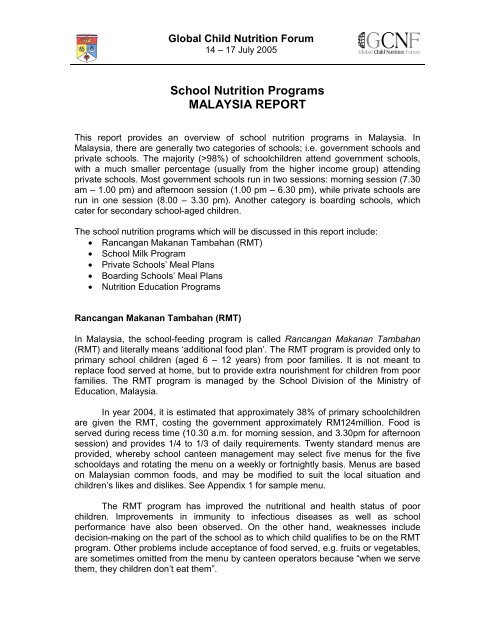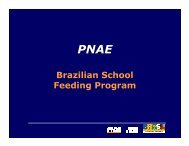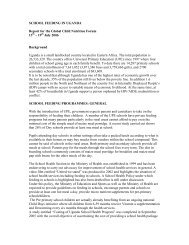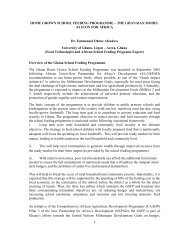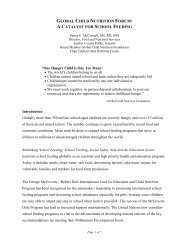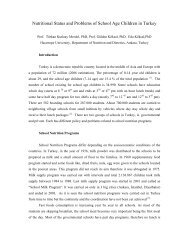School Nutrition Programs MALAYSIA REPORT - Global Child ...
School Nutrition Programs MALAYSIA REPORT - Global Child ...
School Nutrition Programs MALAYSIA REPORT - Global Child ...
You also want an ePaper? Increase the reach of your titles
YUMPU automatically turns print PDFs into web optimized ePapers that Google loves.
<strong>Global</strong> <strong>Child</strong> <strong>Nutrition</strong> Forum14 – 17 July 2005<strong>School</strong> <strong>Nutrition</strong> <strong>Programs</strong><strong>MALAYSIA</strong> <strong>REPORT</strong>This report provides an overview of school nutrition programs in Malaysia. InMalaysia, there are generally two categories of schools; i.e. government schools andprivate schools. The majority (>98%) of schoolchildren attend government schools,with a much smaller percentage (usually from the higher income group) attendingprivate schools. Most government schools run in two sessions: morning session (7.30am – 1.00 pm) and afternoon session (1.00 pm – 6.30 pm), while private schools arerun in one session (8.00 – 3.30 pm). Another category is boarding schools, whichcater for secondary school-aged children.The school nutrition programs which will be discussed in this report include:• Rancangan Makanan Tambahan (RMT)• <strong>School</strong> Milk Program• Private <strong>School</strong>s’ Meal Plans• Boarding <strong>School</strong>s’ Meal Plans• <strong>Nutrition</strong> Education <strong>Programs</strong>Rancangan Makanan Tambahan (RMT)In Malaysia, the school-feeding program is called Rancangan Makanan Tambahan(RMT) and literally means ‘additional food plan’. The RMT program is provided only toprimary school children (aged 6 – 12 years) from poor families. It is not meant toreplace food served at home, but to provide extra nourishment for children from poorfamilies. The RMT program is managed by the <strong>School</strong> Division of the Ministry ofEducation, Malaysia.In year 2004, it is estimated that approximately 38% of primary schoolchildrenare given the RMT, costing the government approximately RM124million. Food isserved during recess time (10.30 a.m. for morning session, and 3.30pm for afternoonsession) and provides 1/4 to 1/3 of daily requirements. Twenty standard menus areprovided, whereby school canteen management may select five menus for the fiveschooldays and rotating the menu on a weekly or fortnightly basis. Menus are basedon Malaysian common foods, and may be modified to suit the local situation andchildren’s likes and dislikes. See Appendix 1 for sample menu.The RMT program has improved the nutritional and health status of poorchildren. Improvements in immunity to infectious diseases as well as schoolperformance have also been observed. On the other hand, weaknesses includedecision-making on the part of the school as to which child qualifies to be on the RMTprogram. Other problems include acceptance of food served, e.g. fruits or vegetables,are sometimes omitted from the menu by canteen operators because “when we servethem, they children don’t eat them”.
<strong>Global</strong> <strong>Child</strong> <strong>Nutrition</strong> Forum14 – 17 July 2005APPENDIX 1Rancangan Makanan Tambahan – Sample MenuMonday- Fried Mihun (rice vermicelli), with vegetables and tofu- Papaya, 1 sliceTuesday- Rice porridge, with meat and peanuts- Banana, 1 wholeWednesday- Roti canai, with sardine gravy- Orange, 1 wholeThursday- Nasi lemak (Rice cooked in coconut milk, served with anchovies, peanuts,slices of cucumber)- Guava, 1 sliceFriday- Curry Mee (wheat noodles served with chicken curry and beansprouts)- Watermelon, 1 slice


